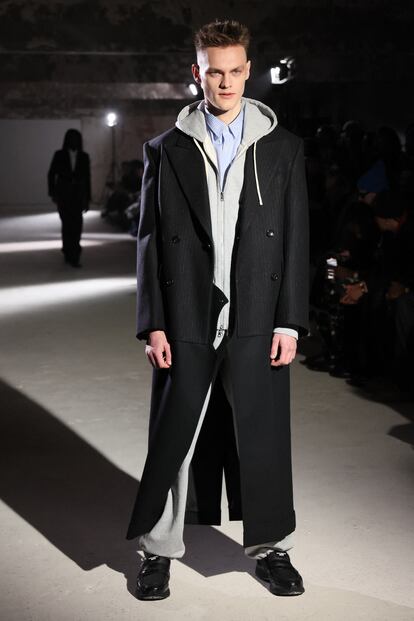‘We don’t want to dress like our parents’: If young people no longer wear trainers, what do they wear?
The decline of the sneaker as the shoe par excellence represents an earthquake in the business model of giant urban fashion brands. But it’s also an opportunity to reclaim and modernize other footwear models, such as moccasins

What started as a rumor grew into a commotion and — as happens with things that are often repeated — ended up being accepted as a universal truth.
For a few years now, in conversations about urban fashion, there’s been a discussion about whether it’s possible to say — without hesitation — that sneaker culture is dead. This trend long put the sports shoe at the center of everything, turning it into a desirable object of status and a commodity ripe for speculation in a resale market that has grown to become a global monster.
Earlier this year, Shawn Stussy — one of the icons of urban fashion and creator of the Stüssy brand — was very direct in declaring the death of sneakers. His theory was simple: if someone like Donald Trump could sell limited edition sneakers, the culture that Stussy helped create already represented the opposite of its origins. The question that arose then, in urban fashion circles, was clear: what now?
To understand the supposed demise of sneaker culture, we have to go back a little, to the period between 2012 and 2022. During this decade, the sneaker became much more than just an icon for some urban subcultures. The proliferation of limited editions and collaborations — many of them with luxury brands — turned this garment into the central element of the clothing of people of all backgrounds and income levels. In other words, sneakers became mainstream. That is, until the bubble burst: in 2023, major sports brands such as Nike or Adidas saw how, for the first time in several years, the growth of sneaker sales stagnated. The drift of streetwear icons — such as Kanye West — didn’t help, either. This led Adidas to cut ties with the artist… but not with his Yeezy brand, which continues to be on the market.

But sneaker culture, some experts argue, hasn’t died just because of an excess of supply and an audience that’s increasingly less concerned about its origins. Matt Welty — a journalist for Complex magazine and host of a podcast about sneakers — recently pointed to another reason: his audience is getting older. “What if I told you that your lack of enthusiasm is a you problem, not a sneaker problem? And that it’s probably because you’re getting older,” Welty wrote. His thesis is that the supposed death of sneakers isn’t so, because, as he asks, “what are you gonna do, walk around barefoot?”
The world beyond the sneaker
Indeed, the weariness of wearing the most exclusive pieces of footwear has led many consumers to stop following the latest developments in the market. Designers and fashion firms linked to streetwear have been exploring the possibilities of footwear beyond the dictatorship of sneakers for some time now. Earlier this year, New Balance presented its new model in collaboration with Japanese designer Junya Watanabe: a hybrid between a sneaker and a moccasin. This officially marked the search for new ways to dress the feet in urban culture. And, in the process, it made it possible for traditional designs to enter the urban universe.
“[Pairing] a loafer with track pants, for example, is totally acceptable now and doesn’t make you look like you forgot your sneakers for gym class,” explained Olie Arnold — the style director at Mr. Porter — to one of the most followed streetwear publications, Highsnobiety. “For me, [loafers] are like the original sneaker — just as comfortable and stylish.”
This isn’t the only case. The firm Reimagine Studio has recently stood out for its hybrids between sneakers and the classic work boot, pushing the limits of what is “wearable” a little further. Other brands with roots in streetwear culture — such as Aimé Leon Doré or Noah — have been betting on the inclusion of loafers or brogues in their marketing proposals for some time. This preppy-to-urban shift was already adopted in the past by brands such as Ralph Lauren
This openness to recovering traditional footwear models is also supported by the tastes of a generation that isn’t tainted by the stereotypes of previous generations. As with the chino trousers — which Generation Z has adopted as an alternative to jeans — the way of dressing the feet is also looking to the past, without preconceived notions. The late Fraser Moss — of the British firm YMC — put it like this: “Their parents are wearing trainers, so kids are rebelling by dressing like their dads once did. It’s a reaction against ubiquity.”
This is one of the reasons why men’s fashion websites and magazines now show us looks in which sportswear is combined with loafers, derby shoes, brogues, or monk straps, considered by the previous generation as an unequivocal sign of the old-fashioned. Indeed, in the world after sneakers, the old is the new. Or, as Moss summed up, “normal has become subversive.”
Sign up for our weekly newsletter to get more English-language news coverage from EL PAÍS USA Edition
Tu suscripción se está usando en otro dispositivo
¿Quieres añadir otro usuario a tu suscripción?
Si continúas leyendo en este dispositivo, no se podrá leer en el otro.
FlechaTu suscripción se está usando en otro dispositivo y solo puedes acceder a EL PAÍS desde un dispositivo a la vez.
Si quieres compartir tu cuenta, cambia tu suscripción a la modalidad Premium, así podrás añadir otro usuario. Cada uno accederá con su propia cuenta de email, lo que os permitirá personalizar vuestra experiencia en EL PAÍS.
¿Tienes una suscripción de empresa? Accede aquí para contratar más cuentas.
En el caso de no saber quién está usando tu cuenta, te recomendamos cambiar tu contraseña aquí.
Si decides continuar compartiendo tu cuenta, este mensaje se mostrará en tu dispositivo y en el de la otra persona que está usando tu cuenta de forma indefinida, afectando a tu experiencia de lectura. Puedes consultar aquí los términos y condiciones de la suscripción digital.
More information
Últimas noticias
Alain Aspect, Nobel laureate in physics: ‘Einstein was so smart that he would have had to recognize quantum entanglement’
Imelda Castro, the woman who wants to rule the cartel battleground of Sinaloa
The new victims of the Republican war on Obamacare: Millions hit by soaring health insurance premiums
A country divided on migrant rights: Some US states expand protections while others restrict them
Most viewed
- David King, chemist: ‘There are scientists studying how to cool the planet; nobody should stop these experiments from happening’
- Reinhard Genzel, Nobel laureate in physics: ‘One-minute videos will never give you the truth’
- Oona Chaplin: ‘I told James Cameron that I was living in a treehouse and starting a permaculture project with a friend’
- Sinaloa Cartel war is taking its toll on Los Chapitos
- Mexico completes its trade shift with the entry into force of tariffs on China and countries without trade agreements










































